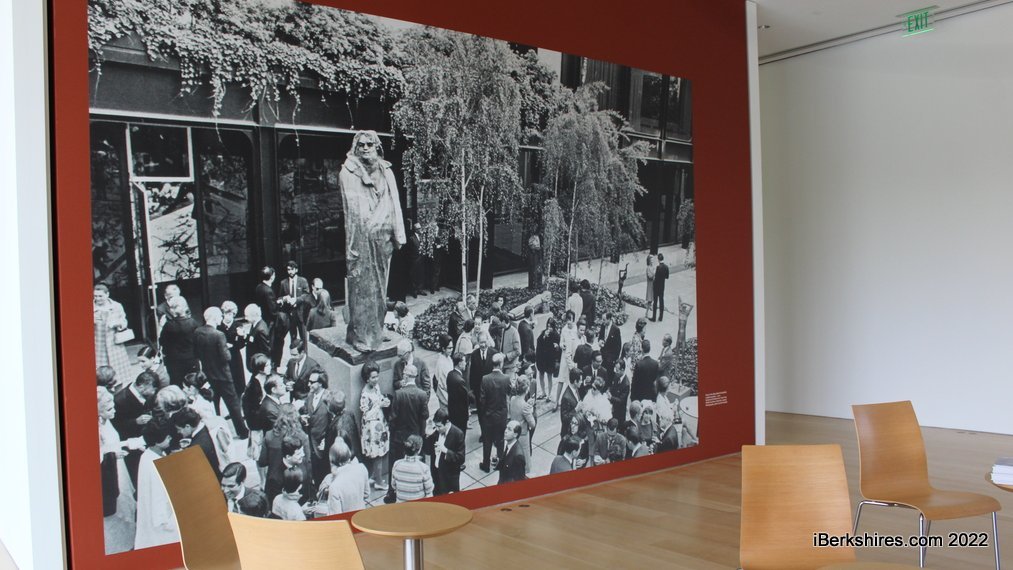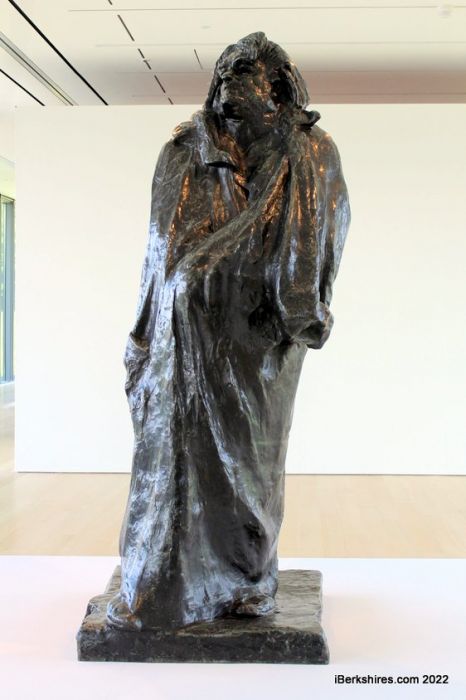Clark Art Features 'Rodin in the United States'By Sabrina Damms, iBerkshires Staff
06:02AM / Sunday, June 26, 2022 | |
 The Rodin library with a photograph featuring 'Monument to Balzac' at the Clark Art. The Rodin library with a photograph featuring 'Monument to Balzac' at the Clark Art. |

'Monument to Balzac' is on display off the museum's lobby.
WILLIAMSTOWN, Mass. — One of the largest exhibits of the works of Auguste Rodin seen in the United States in the past 40 years is now on view at the Clark Art Institute.
The exhibit consists of 50 sculptures and 25 drawings from American museums and private collections that collectively demonstrate the story of the collectors, agents, art historians, and critics who worked to make Rodin known in America.
Although there have been many exhibits on Rodin, less attention has been directed to toward the French modernist's legacy in the United States. The Clark exhibit considers Rodin's influence and reputation on America from 1893 to the present day.
Part of the exhibit can be found on the first floor when entering the Clark, to the right of the main lobby, where Rodin's "Monument to Balzac" is on display. Visitors can sit in the "Rodin library" filled with books on sculptor and where sketchpads with pencils are available for use.
The rest of the exhibit is on display within the museum and separated into three parts: "The Collectors," "The Era of Museums" and "The Revival."
Each of these sections shows the progression of Rodin's work and career. Throughout the exhibit, visitors can see the progression of his work through some of his original plaster models and then the completed pieces.
On display are also some sculptures that Rodin did not finish, giving the viewer a chance to see the artist's process. Rodin was considered unconventional at the time for many reasons including how some of his art looked unfinished to contemporaries and bear traces of his process.
"The Collectors" section of the exhibition showed the first group of Rodin's art that was presented in the United States beginning with pieces put on display at the Chicago World's Fair in 1893.
Born in 1840 into a working-class family in Paris, he studied art and math in his youth -- but was rejected by École des Beaux-Arts --- dabbled with idea of taking religious orders, and worked as a craftsman on ornamental designs and on public commissions. He finally opened a studio where he worked with live models in the early 1880s.
He was interested in expressing human emotion and often reused parts from previous pieces. Initially, he was not very popular in the United States because of the provocative depictions some of his sculptures showed. These pieces were moved to a private space and were only accessible by request.
He was known for breaking convention by celebrating classical beauty by representing the people around him. Some of his best known works are the "The Thinker" and "The Kiss."
With the influence of many collectors, artists, and curators, including Rodin's model Katherine Seney Simpson; American actor, dancer, and choreographer Loïe Fuller; philanthropist Alma De Bretteville Spreckels, and more, Rodin's work slowly began to gain popularity as it entered the private and public collections.
The "Era of Museums" section of the exhibition follows the reputation of his work following his death in 1917. Rodin left the contents of his studio to the French state with the condition that a museum would be founded for his work in Hôtel Biron in Paris.
The museum had instructions from the artist that casts be made in bronze of his sculptures that would finance the museum's operations and increase the knowledge of his work.
American museums and collectors started to expand their Rodin collections gathered from gifts or purchases but many institutions favored displaying the finished narrative subjects. The unfinished works that are praised today were sent to storage until World War II.
The final section of the exhibit, "The Revival," examines his work from 1954 until the present day when scholars and critics started to recognize the daring and modernity of his work after the director of the Museum of Modern Art Alfred Barr requested a bronze cast of Rodin's "Monument to Balzac" be made.
Barr considered the piece "one of the greatest sculptures in the history of Western art" leading to Rodin's work becoming fully established in the united states.
This exhibit demonstrates the progression of his pieces becoming fully established in the United States.
| 
